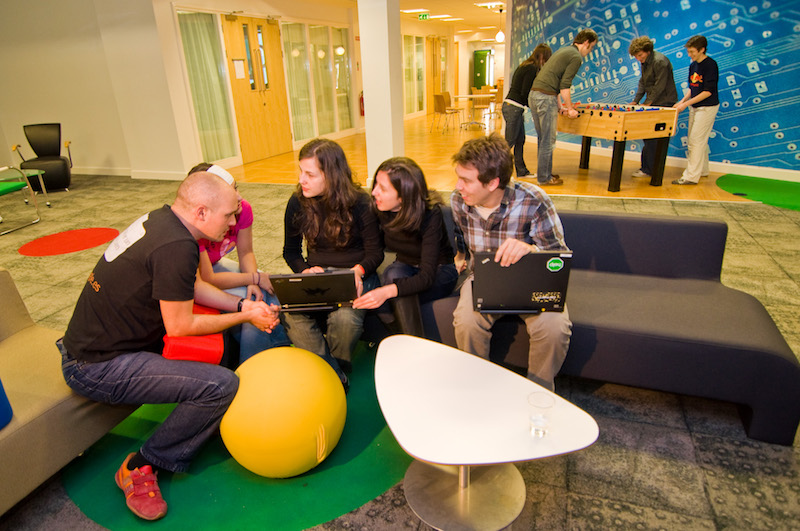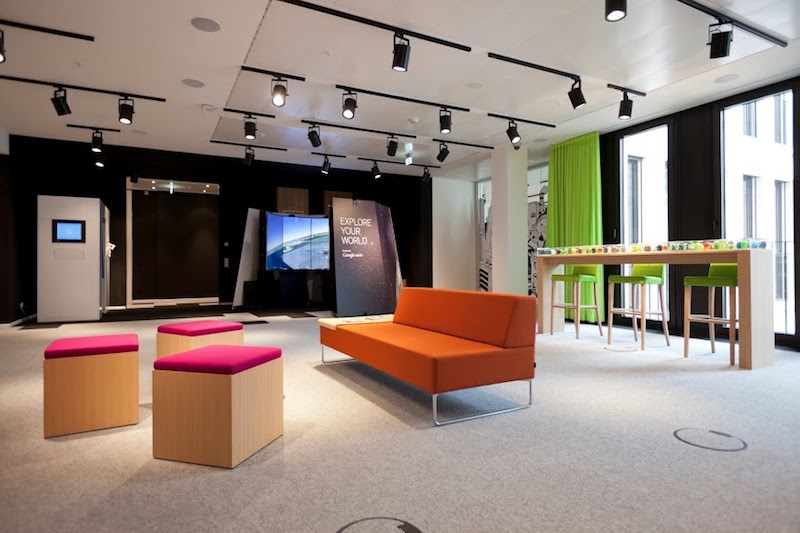Innovation – 10 tips on how to promote innovation in your company
Everyone wants an innovative company. But what does that mean? And above all: what can you do to achieve this? Here are 10 easy-to-implement suggestions on how you can promote innovation and creativity in your company:
Innovation in the company Tip 1
Deal constructively with mistakes and criticism!
In order to try something new, you need security: above all, the certainty that an experiment can go wrong without serious consequences. After all, who wants to take a risk if they are afraid that everything will blow up in their face? When you or your employees venture into new territory, you cannot know in advance whether everything will go as planned. You will only be able to find out whether an idea works through trial and error. Trial makes perfect. If your organization is benevolent and signals acceptance of mistakes or failed attempts, then your employees will become more courageous. – Especially when your employees know that no thunderstorm will descend on them even if they lose money.
Trying out new things means questioning and criticizing the old. That can be uncomfortable. But it is precisely here that there are many opportunities for improvement, even innovation. After all, someone has thought about a product or a process – so it’s worth listening. It could be a valuable idea! Conclusion: In your company, constructive criticism should not only be allowed, but encouraged.
Innovation in the company Tip 2
You need employees who are open to new ideas.
Some people feel comfortable when things go their usual way, others love it when something new and exciting happens. We humans are different. These preferences are partly innate and partly based on experience. It is easy to understand that people with a preservationist tendency are good at preserving what already exists, but do not exactly welcome innovation.
However, if you want to promote innovation, it is important that you also have employees in your ranks who appreciate new things – who are even looking for them. Here too: It’s all in the mix! 30 – 50% of employees should enjoy the new. Some companies have a conservative approach: The majority of the workforce loves the old ways. This is where cultural change becomes difficult. What to do? One option would be to deliberately bring a different type of people on board and gradually change the culture. Another option is to set up a new unit with innovative, open-minded employees.
>>> Read here: Recruiting: How we found the perfect employee.
A good example of innovation within a company is Google. Here Google Dublin:

Innovation in the company Tip 3
Create flexible systems!
You’ve probably heard this before: “But we’ve always done it this way!”. The speaker wants to prevent change and carry on as before. However, being innovative means not sticking to existing structures, but opening up to new ideas. The easiest way to achieve this is to avoid fixed structures – such as “always do it this way” – in the first place. How can you implement this in your company? An alternative to departments that exist for long periods of time are project groups that only come together for the duration of a project and are then disbanded. Employees who often adapt to new situations and structures automatically remain flexible and open to new ideas. When work structures change frequently, change is inherent in the system. Change management becomes unnecessary, as change is then part of everyday life.
Innovation in the company Tip 4
Ensure flexible hierarchies!
Hierarchies are social structures of a system, e.g. a company. If the system, i.e. the company, wants to remain flexible, it is advisable to make the hierarchies flexible too. One way of implementing this is: an employee can be a manager at times and not at times. Leadership is therefore a task, but not a status. You should confidently dispense with symbols that indicate status, such as special company cars or special rooms. Regine Stachelhaus, head of Hewlett Packard Germany (2001-2008), set a good example at the beginning of the millennium: she sat together with her employees in the open-plan office. This type of agility promotes innovation, as it encourages openness in the system.
Innovation in the company Tip 5
Welcome the safe risk!
Innovation is risk: you don’t know whether anything will come of it. In this respect, it makes sense to allocate capital to innovation that is not necessarily needed. In this way, this sum, which has already been written off, is used as an opportunity for the future. And if the money is lost, there is no dramatic loss. Sunk is sunk. Gone is gone!
>>> Read here: How super-entrepreneurs deal with risk and innovation.
Innovation in the company Tip 6
Reward different thinking instead of conformity!
What good is it if all employees are open to innovation and communicate their ideas, but managers keep rejecting them? As you can see, things can only really move forward if the management also finds new things exciting. This is evident when you listen to your employees’ suggestions. Even if the ideas are not what you had in mind, you should by no means put your employees under fire. Appreciate the fact that they dare to deviate from the beaten track and explore new territory. This will ensure that your employees continue to come to you with their ideas. Because the more ideas that emerge, the more worthwhile they are.
A room from Google Berlin:

Innovation in the company Tip 7
Create creative freedom, both in terms of location and time!
You need space and time to create something. Imagine you have to develop great ideas on the side in your busy, stressful everyday life. You may be asking yourself: “When should I do this?”. You’re right – great ideas rarely come between the door and the door. Allow yourself and your employees time that can be used for projects that are still in their infancy. Or bring people together in workshops to actively tackle innovation. Or release employees to be innovative. Because when innovations have to compete with day-to-day business for the resource of time, the innovations are usually left empty-handed.
So make sure you have creative time! To give innovation a place in your company, you need creative spaces as well as creative times. Google is setting an example with its interior design: Google offices feature rocking chairs, table football, beach chairs, even egg-shaped meeting rooms or pubs for meetings. The interior of the Hasso Plattner Institute also invites you to be creative: there are seat cushions, high tables or you can use the open spaces to move around while thinking. There are plenty of creative tools available. There are painting utensils, sticky notes and yes, even Lego bricks everywhere. Who can resist their own creativity?
Inspiration – Latin for: inspiratio ‘inspiration’, ‘breathing into’, from ‘into’ and spirare ‘to breathe’, ‘to breathe’; cf. spiritus ‘breath’, ‘soul’, ‘spirit’
Innovation in the company Tip 8
Let inspiration into your home!
We know that artists need inspiration to create something. It’s no different for the average creative. They also need a breath of fresh air from outside instead of just stirring their own soup. Inspiration comes from the Latin and means “to breathe in” or “to bring in the spirit”. It is therefore not surprising that what stimulates the mind inspires. (Permanent) learning is of particular importance. When you deal with new content, new thoughts come all by themselves. What could inspiration look like in your company? These can be lectures, workshops or even people with different opinions presenting themselves in your company. Because changes of perspective are very stimulating.
An easy way to be inspired by other points of view is to meet new people and exchange ideas. You’re probably familiar with this situation: you’re having a conversation and a sentence from the person you’re talking to has given you some new ideas. So treat your employees to a “mental makeover”! Make sure that you don’t just work with the people you are used to, but that the teams are mixed – and that there is enough fresh input from outside your company. Where new things come together, innovation arises because people enrich each other intellectually.
With this in mind, we would like to invite you to get inspired and exchange ideas in our
Leadership Lounge
. Meet colleagues and learn new things about management and entrepreneurship:
At the SEMINARIS CampusHotel Berlin, speakers from business, companies and academia regularly speak on topics relating to corporate management, employee management and personnel development.
Innovation in the company Tip 9
Work with innovation processes!
Creative freedom is all well and good, but can’t innovation be approached in a more focused way? Good news: Yes, there are numerous techniques you can use to target innovation instead of waiting to see if someone comes up with something by chance. Structured innovation needs methods that work. One of these is the“Design Thinking” process, which is taught at the Hasso Plattner Institute.
One of the aims of design thinking is to collect as many ideas as possible and then test them. Very different people are brought together and made capable of working together in order to then go through the innovation process step by step. This gives you many different perspectives at the same time. The Design Thinking process also involves listening to the opinions and perspectives of random passers-by. This method is based on the work of designers, who also go through many phases of brainstorming, selection and testing until they get from the idea to the finished product.
Innovation in the company Tip 10
Celebrate something new!
Here’s a suggestion that’s great fun: Celebrate something new! Give innovations a forum. Honor the developer of an idea. One example: Zalando awards an innovation prize to its It developers every year. The prize is endowed with one week of free time. But even if there’s no big prize, it’s worth welcoming the newcomer with a small celebration and publicizing the idea to your employees. This will communicate far more than just the newly developed approach itself: Your employees can be certain that new and innovative ideas have great value in your company. And, of course, the prospect of a celebration and an award is an attractive incentive to let your own ideas play out and express them. Because it’s fun, safe – and the reward is already waiting!
We wish you every success with the implementation!
Do you have any questions or ideas? We look forward to your comments.













